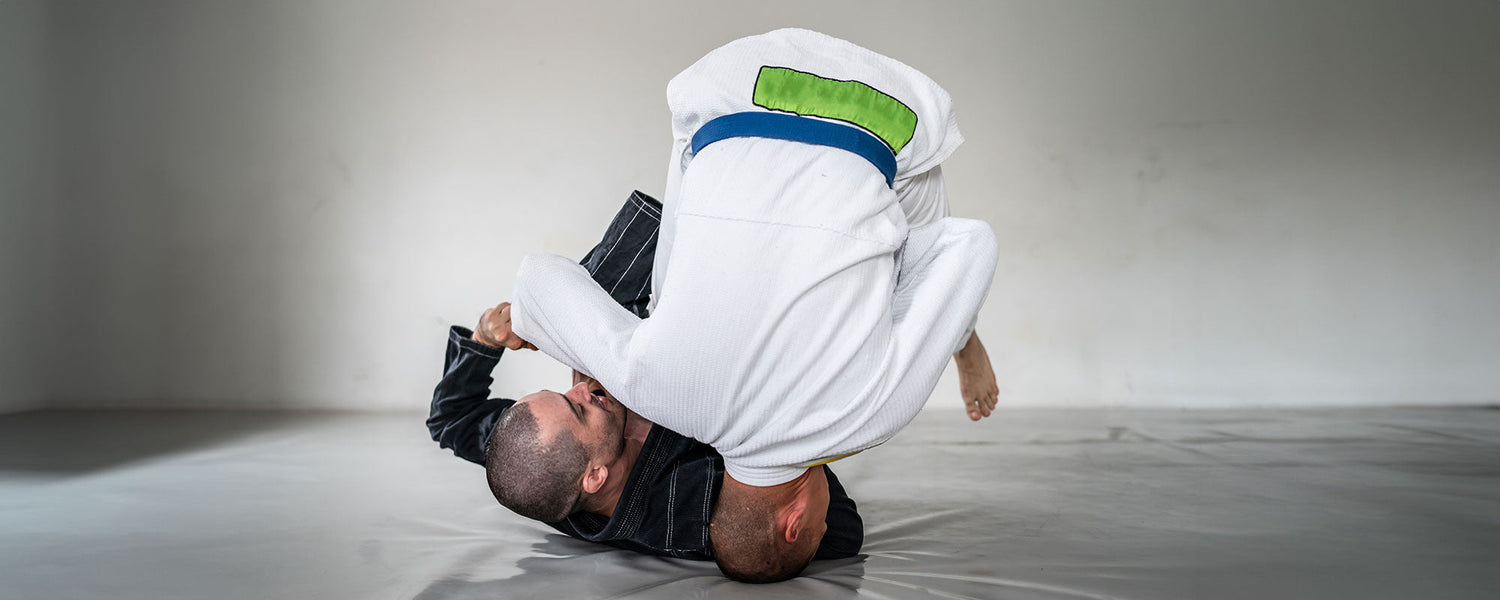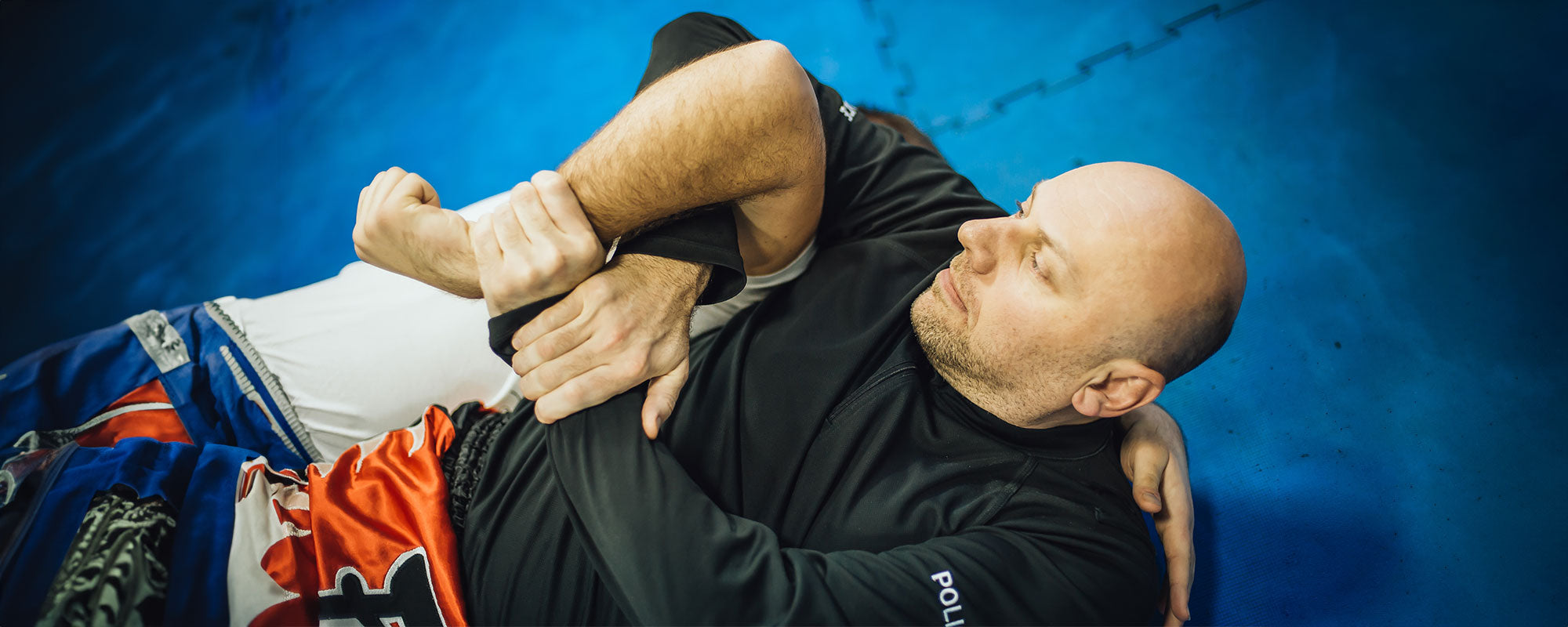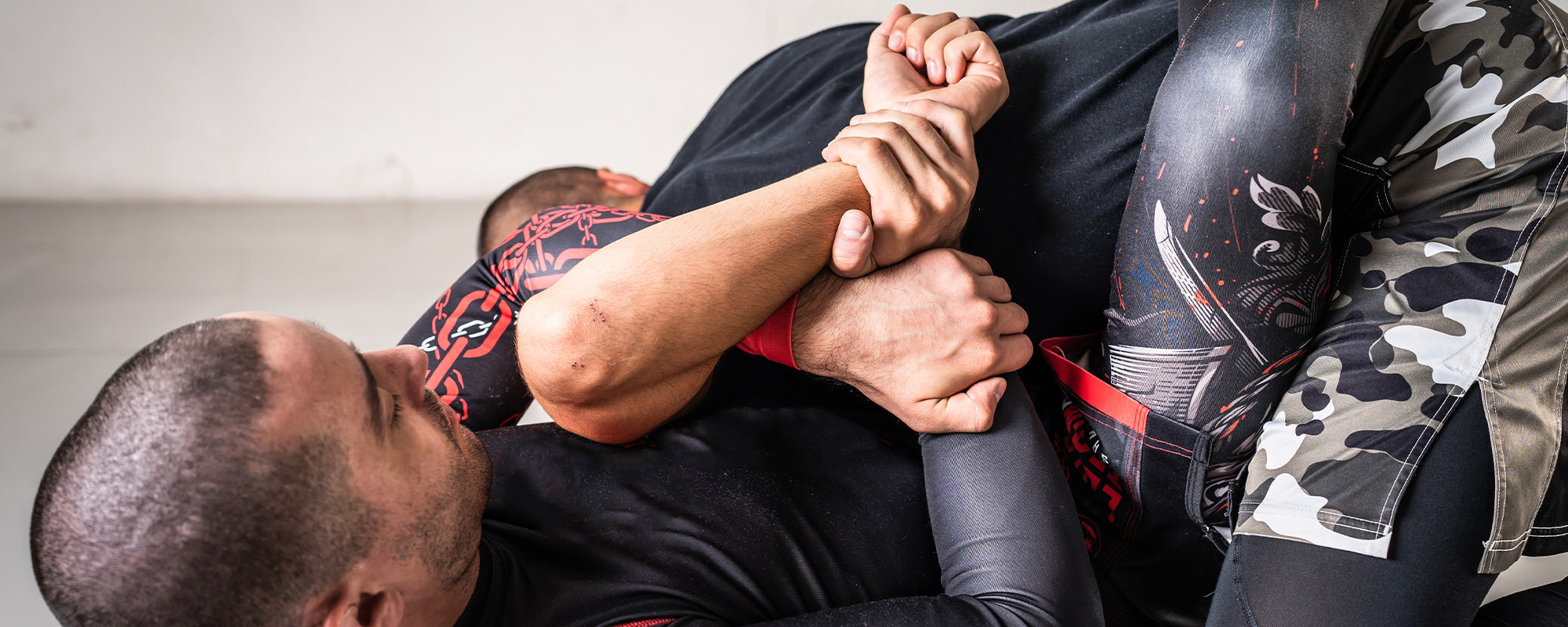Table of content
1. Intro of Loop Choke in BJJ
1.1. Significance of chokes in BJJ

The loop choke is one of BJJ's most hidden and strongest chokes. It is applied when a player switches his submission from one variation to another and counts as a takedown counter technique. Loop chokes are some of the most compelling submissions from several positions, such as guard passes, half-guard, side control, and while defending against a takedown.
Using chokes for the first time might be uncomfortable and challenging for BJJ players. The fighter should know the correct way and the reason for using this move so that he does not create any problems.
Continuous drilling of loop choke makes it easy for them to apply from various entries in a different position. This submission move is made by putting your arm around your opponent's collar, then looping your hand to the opposite side and pulling down on their head. The pressure is quite uncomfortable and cuts off blood flow to the brain, and eventually, they would have no choice but to tap.
1.2. Description of Loop Choke in BJJ
Chokes are an essential part of BJJ because they can be used by individuals of different sizes and shapes, even in a BJJ Gi collar competition, by making it much more effortless and versatile submission moves to use. Participants use the opponent's gi to tighten the choke , cut off blood flow through the neck, and take GI as an attachment of the body where they can isolate, counter, and maintain control over the opponent and submit. This submission move is like a bow and arrow, which can be applied in GI and not in GI competition. The use of the GI can make the competition more complex.
1.3. Benefit of GI collar in BJJ Chokes
The loop choke can be applied from an open guard position while sitting. If a Jiu-Jitsu fighter plays choke from a guard position, starting with a cross-collar grip is essential. One of the classic techniques to apply a choke is by the cross collar. The opponent's gi collar helps put pressure against the neck. By gripping your fingers into the collar and dragging them sideways over your neck, compressing both carotid arteries can lead to a submission.
BJJ Collar Drag and Chokes:
Collar drag is another approach to pulling off the Gi collar to unbalance the opponent and apply a choke. By pulling the collar of the gi, you can drag the open head down, shift your moves into a choke submission, and secure the submission. Collar drag can also be applied from different chokes. It can create openings and control the opponent's posture, making using these advanced submissions much easier. This controlling position is essential to smoothly transitioning between different choke setups.
2. Fundamental of BJJ Loop Choke
A seated open guard sets the immediate loop choke. If the player is playing guard, start with the cross-collar grip, in which the player tries to get under the opponent's neck with the other hand and pushes their head down to attack. Drag their free arm inside and get behind their neck up to connect at the wrist of the choke-holding hand.
The loosened grip is the follow-up when the player in BJJ adjusts his movement and uses a cross collar. Their arm will be free to connect around their opponent's head.
The loose cross-collar grip is crucial so their arm can easily cross the chin and up to cover against necks while the other hand goes behind.
2.1. Types of BJJ Loop Chokes used in GI and no GI grappling

The loop choke is a substantial move that demands precise grips, a wise body role, and the accurate use of the BJJ Gi collar. This choke is understood by knowing how to position your body, use the lapel, and form a tight loop close to your opponent's neck. BJJ loop choke is practiced and evolves into a very fluid and efficient technique that can be a big helping hand in both training and competition.
With your choking hand, pull the lapel back and push your body to the maximum to send a strong loop around the neck of the opponent. The next phase is to maintain a firm grip and a tight lapel. This choke will narrow down and compress the arteries in the neck of the opponent,
Variations designed for positions, like closed and open guards, are crucial factors to consider.
Form top position or flying setup
Flying setup is a dynamic and effective technique that starts from the standard position.
- It begins with a tight grip on the opponent's lapel from one hand. This is done when a player performs a snap down by pulling their opponent's head, making a firm grip.
- Hold the opponent with one hand while the other creates a loop. Bring your hand under their arm or around their neck to let the loop choke.
- Apply the pressure by pulling the opponent's collar and making a tight choke.
- While the loop choke is most effective when applied from the top position, it also works well when you are on the bottom side of the half guard.
- Half guard is an intermediate position, a hold that leads to either getting into a better position to achieve goals or a worse position to fight back.
- The loop choke is a shifty way to switch from the half guard to a dominant position. It's a way to apply pressure suggestions to your opponent that make him act in ways that help you transition to a better position.
Front headlock position
The most effective step for foot-locking the opponent is to get them from a front headlock position. Meanwhile, the sitting and butterfly guards are also advantageous moments to start an attack.
- Before you perform this choke, the lapel is essential as it controls your opponent , and by managing them, you can effectively choke them.
- In every case, a well-executed mix of the rolling way and correct head force will lead to a practical finish.
- When you want to avoid getting stuck at the bottom and unable to move much, try not to move as much in your guard by orienting yourself under your opponent.
- With a grip in place, you only arise victorious.
The half-guard
The half-guard is essential for setting up a loop choke in Brazilian Jiu-Jitsu practice sessions or competitions. You can move from either the bottom position of a half-guard or a half-guard bottom.
- It concentrates on the top position, starting with a hold on your opponent's collar as a first step.
- Creating the loop choke from this setup requires a change of your feet and a grip around your opponent's neck like a guillotine.
- Additionally, the BJJ player uses the arm wrapped around the head to control the lapel.
- Furthermore, having an undertook from your opponent will simplify the execution of the product.
- You may release your leg to maintain side control or execute a finish from a headlock stance.
Closed guard
The closed guard is another place to set this particular submission. It can be submitted more effortlessly than full guard since BJJ fighters don't care much about a lapel grip from there.
The idea here is to come out of the closed guard and hook your arm through the opponent's head.
- This is even better if you can do that while maintaining your posture.
- The closed guard is another place to set this particular submission. It can be submitted more effortlessly than full guard since BJJ fighters don't care much about a lapel grip from there.
- The idea here is to come out of the closed guard and hook your arm through the opponent's head.
- This is even better if you can do that while maintaining your posture.
3. Execution, Body Positions, and Holds in BJJ Loop Choke
In BJJ, "loop choke" is one of the most compelling submissions, whereby it catches your opponent by surprise in a way that may result in a win in just a couple of seconds. Here are the essential body positions and holds to understand while executing the loop choke:
3.1. Steps of Execution of Loop Choke in BJJ
Starting Step:
You get into a close guard position by wrapping your legs around the opponent's waist. To hook them in, catch them in a turtle and untuck their feet. This will allow the player to get behind their back and knees. Now, try to control their position with a firm and tightening grip.
Hold and Isolate the opponent:
Use the choking hand technique, in which the player clutches the opportunity, controlling it closer to your chest. Make sure the clutches are firm and close to the neck.
You use your right hand to clench the opponent's arm near you. You'd drag this arm over your body to create a greater choking danger. You may use your GI sleeve to help your arm into the proper position.
Form the Choke:
Bring your right hand near his collar; at this point, your left hand should go slightly underneath his head. This will allow the loop choke to lock on your neck.
In securing the hand behind his neck, your left hand should be in such a position to enable you to grab his collar and pull it tight. This amounts to gripping his neck, and he will submit.
Final Adjustments and Execution:
When you are the primary contributor of extra force, place your body close to the opponent's head. This will change the position, and the collar will be pressed well into the neck.
Keep your arm in such a position that there should not be an inch to get freedom.
Push your body with all your strength with the choking hand to pass a brutal loop choke around the neck of the opponent.
3.2. Body Positioning in BJJ

Side Control:
In the side control , you will be at a 90-degree angle from your opponent with your chest against their core and your weight aligned to keep them flat on their back. To execute a loop choke, the collar must be gripped, and the position and grip on the opponent must be firm and placed right to provide no room for escaping. Your body should be aligned so that downward pressure on the neck of the opponent is applied to enhance the effectiveness of the choke. The choke is to be pressed onto your opponent's carotid arteries, which will enable him to submit successfully.
Closed Guard Position:
You can perform a BJJ loop choke from the close guard position, where your legs are locked around the opponent's waist to hold onto and maintain balance.
This position gives you Control over their posture and movements. Keep your knees, back, and hips closer to the opponent's body; this will keep them close and make it harder for them to escape. Squeeze your legs and maintain the right lock so your opponent stops from creating distance.
Accuracy of Hip and Body Movement
Your body position matters to an effective loop choke. You must adjust your hip position by shifting your hips at different angles. You can also increase the intensity of the choke.
Shifting your position and angling your core or body weight can also increase the density of the choke. For example, leaning to one side can help pull the opposite head down and make the choke tighter.
3.3. Holds for Establishing the Loop Choke in BJJ

Operating Choking Hand Grip:
The choking hand grabs the opponent's collar to create the choke. Ensure that the grip is deep and secure and that the collar and your figure are deep inside the opponent's collar. A solid grip around the collar allows you to control and tighten the loop choke. The other hand keeps the choke in place and controls the opponent. Usually, it draws the opponent's arm across their body to pull and push his collar, which helps to make the loop and gives the choke more power. Setting up the loop and making the choke effective becomes easy.
Pull the opponent's collar towards you to tighten the loop while keeping the grip firm.
The non-choking hand helps enhance the choke's effectiveness, allowing one to press harder and submit.
Body Positioning:
Alteration in body position can also enhance the tightness of the choke. Keep your head close to the opposite body and start shifting your body gradually towards the side where you are holding tight. Your shoulder should be pressed against your opposite neck to offer extreme pressure.
A slight adjustment of your hips and body can change the angle of the choking technique. For example, in a close guard position, use the legs to pull the opponent's head toward you and maintain Control. In the open guard position, use the legs to push or pull the body to submit a choke.
This weight transfer causes them to clench their neck on the lapel, and the pressure increases.
Importance of Leg Positioning in BJJ:
The leg's position is relevant for maintaining Control in the loop choke. Your legs must be kept so that it is hard for the opponent to shift. The legs set your opponent's posture and prevent them from getting away.
Just keep your legs active so they will not get into their posture and start escaping.
Use the legs to pull him close to you so he cannot move. The setup keeps him in a stiff position, and from there, you can go for a loop choke and submit him.
Completing the Choke:
Complete the loop choke by applying firm pressure, pulling upwards on the collar, and driving your opener head towards your chest. Your arm and shoulder should drive onto the neck as your collar grip completes the loop. You can often refine the choke by subtly clamping down or adjusting your body at various angles to tighten the loop so your opponent can compress their neck and tap out.
Next, you will hold tight and squeeze the choke by pulling your left elbow toward your hip. This will cause the choke to begin narrowing and pressing the arteries in your opponent's neck. You now must keep the pressure on, both by squeezing and pulling. This pressure is directly applied to the neck by the opponent's compressing his carotid arteries, thus making it a successful submission.
4. Conclusion

The loop choke is one of the most effective weapons; it is one of the most flexible submissions in BJJ because it can be applied in different situations, such as during guard passing, half-guard, side control, and while countering takedowns. To avoid the danger with it, learning how to perform it and for what reason one performs it in great detail should be acquired by a practitioner. Another supplementary advantage of long-term loop choke training is that one will be in a position to have a smooth entry from different angles and positions.
One of the premier reasons chokes are considered a vital part of BJJ is that they can be effectively applied by practitioners of many sizes and body types, placing them in a unique category as highly versatile submission methods. In these chokes, the GI collar is used to make it even more complex, making the game much harder during competition, as is the case with the loop choke applicable to both formats.
5. Frequently Asked Questions (FAQs)
Q: What are the most common BJJ loop choke arrangements for diverse positions?
There are many distinctions, from closed to open to half-guard guard, depending on where you use the loop choke. For the BJJ practitioner, the distinctions in using the loop choke should be more beneficial for conditioning and matching.
Q: How can you set up the loop choke from this guard position?
Pressing the opponent's neck with the GI collar will lead to a choke. You can effectively set up a BJJ loop choke from the half-guard position. The half guard is one of the requisites in Brazilian Jiu-Jitsu for executing a successful attempt at the loop choke. It also allows the guard to initiate the attacks and finishes on top and bottom, meeting the essential criteria for the loop choke.
Q: Why is the choke considered classic in grappling movements in BJJ?
Chokes are sleek class wrestling submission methods. These techniques give artists of all shapes and sizes an exciting advantage, mainly when using a GI collar.












Leave a comment
This site is protected by hCaptcha and the hCaptcha Privacy Policy and Terms of Service apply.